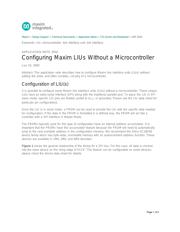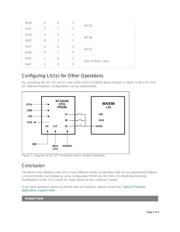herunterladen

Maxim > Design Support > Technical Documents > Application Notes > T/E Carrier and Packetized > APP 3556
Keywords: LIU, microcontroller, line interface unit, line interface
APPLICATION NOTE 3556
Configuring Maxim LIUs Without a Microcontroller
Jun 15, 2005
Abstract: This application note describes how to configure Maxim line interface units (LIUs) without
adding the extra, and often complex, circuitry of a microcontroller.
Configuration of LIU(s)
It is possible to configure some Maxim line interface units (LIUs) without a microcontroller. These unique
LIUs have an extra serial interface (SPI) along with the traditional parallel port. To place the LIU in SPI
slave mode, specific LIU pins are floated, pulled to V
CC
, or grounded. Please see the LIU data sheet for
particular pin configurations.
Once the LIU is in serial mode, a PROM can be used to provide the LIU with the specific data needed
for configuration. If the data in the PROM is formatted in a defined way, the PROM will act like a
controller with a SPI interface in Master Mode.
The PROMs typically used for this type of configuration have an internal address accumulator. It is
important that the PROMs have this accumulator feature because the PROM will need to automatically
jump to the next available address in the configuration memory. We recommend the Xilinx XC18V00
device family which has byte-wide, nonvolatile memory with an autoincrement address function. These
devices are available in 1Mb, 2Mb, and 4Mb densities.
Figure 1 shows the general relationship of the timing for a SPI bus. For this case, all data is clocked
into the slave device on the rising edge of SCLK. This feature can be configurable on some devices;
please check the device data sheet for details.
Page 1 of 5






